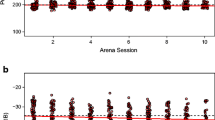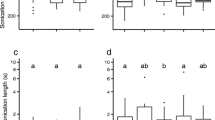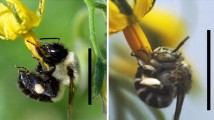Summary
Can bees accurately gauge accumulating bodily pollen as they harvest pollen from flowers? Several recent reports conclude that bees fail to assess pollen harvest rates when foraging for nectar and pollen. A native nightshade (Solanum elaeagnifolium Cavanilles) that is visited exclusively for pollen by both solitary and social bees (eg. Ptiloglossa and Bombus) was studied in SE Arizona and SW New Mexico. The flowers have no nectaries. Two experiments were deployed that eliminated “pollen feedback” to the bees by experimentally manipulating flowers prior to bee visits. The two methods were 1) plugging poricidal anthers with glue and 2) emptying anthers of pollen by vibration prior to bee visitation. Both experiments demonstrated that bees directly assess pollen harvest on a flower-by-flower basis, and significantly tailor their handling times, number of vibratile buzzes per flower and grooming bouts according to the ongoing harvest on a given flower. In comparison to experimental flowers, floral handling times were extended for both Bombus and Ptiloglossa on virgin flowers. Greater numbers of intrafloral buzzes and numbers of times bees groomed pollen and packed it into their scopae while still on the flower were also more frequent at virgin versus experimental flowers. Flowers with glued andreocia received uniformly brief visits from Bombus and Ptiloglossa with fewer sonications and virtually no bouts of grooming. Curtailed handling with few buzzes and grooms also characterized visits to our manually harvested flowers wherein pollen was artificially depleted. Sonicating bees respond positively to pollen-feedback while harvesting from individual flowers, and therefore we expect them to adjust their harvesting tempo according to the currency of available pollen (standing crop) within Solanum floral patches.
Similar content being viewed by others
References
Bowers KAW (1975) The pollination ecology of Solanum rostratum (Solanaceae). Am J Bot 62:633–638
Buchmann SL (1978) Vibratile (“Buzz”) Pollination in Angiosperms with Poricidally Dehiscent Anthers. Ph.D. dissertation in Entomology, University of California, Davis, CA., p 238
Buchmann SL (1983) Buzz Pollination in Angiosperms. In: Jones CE, Little RJ (eds) Handbook of Experimental Pollination Biology, Van Nostrand-Rheinhold Inc., N.Y., pp 73–113
Buchmann SL (1985) Bees Use Vibration to Aid Pollen Collection from Non-Poricidal Flowers. J Kans Entomol Soc 58(3):517–525
Buchmann SL (1986) Vibratile Pollination in Solanum and Lycopersicon: A Look at Pollen Chemistry. In: D'Arcy WG (ed) Solanaceae Systematic and Biology, Columbia University Press, pp 237–252
Buchmann SL, Hurley JP (1978) A Biophysical Model for Buzz Pollination in Angiosperms. J Theor Biol 72:639–657
Buchmann SL, Jones CE, Colin LJ (1977) Vibratile Pollination of Solanum douglasii and S. xanti (Solanaceae) in Southern California. Wasmann J Biol 35(1):1–25
Cane JH, Buchmann (1989) Novel Pollen-Harvesting Behavior by the Bee Protandrena mexicanorum (Hymenoptera: Andrenidae). J Insect Behavior 2(3):431–436
Cane JH, Payne JA (1988) Foraging ecology of the bee Habropoda laboriosa (Hymenoptera: Anthophoridae), an oligolege of blueberries (Ericaceae: Vaccinium) in the southeastern United States. Ann Entomol Soc Am 81(3):419–427
Harris JA (1905) The dehiscence of anthers by apical pores. Missouri Bot Gard 16th Ann Rept 167–257
Haynes J, Mesler M (1985) Pollen foraging by bumblebees: Foraging patterns and efficiency on Lupinus polyphyllus. Oecologia 61:249–253
Hodges CM, Miller RB (1981) Pollinator Flight Directionality and the Assessment of Pollen Returns. Oecologia 50:376–379
Linsley EG, Cazier MA (1963) Further observations on bees which take pollen plants of the genus Solanum. J Kans Entomol Soc 51:531–546
Pellmyr O (1988) Bumble Bees (Hymenoptera: Apidae) Assess Pollen Availability in Anemonopsis macrophylla (Ranunculaceae) Through Floral Shape. Ann Ent Soc Am 81(5):792–797
SAS Institute (1985) SAS user's guide: statistics, version 5 ed. SAS Institued Inc., Cary, NC
Sokal RR, Rohlf FJ (1981) Biometry. 2nd ed., W.H. Freeman and Co., NY
Vogel S (1978) Evolutionary shifts from reward to deception in pollen flowers. In: The Pollination of Flowers by Insects (Linnean Soc. Symp. Series No. 6) pp 89–96
Zimmermann M (1982) Optimal Foraging: Random Movement by Pollen Collection Bumblebees. Oecologia 53:394–398
Author information
Authors and Affiliations
Rights and permissions
About this article
Cite this article
Buchmann, S.L., Cane, J.H. Bees assess pollen returns while sonicating Solanum flowers. Oecologia 81, 289–294 (1989). https://doi.org/10.1007/BF00377073
Received:
Accepted:
Issue Date:
DOI: https://doi.org/10.1007/BF00377073




